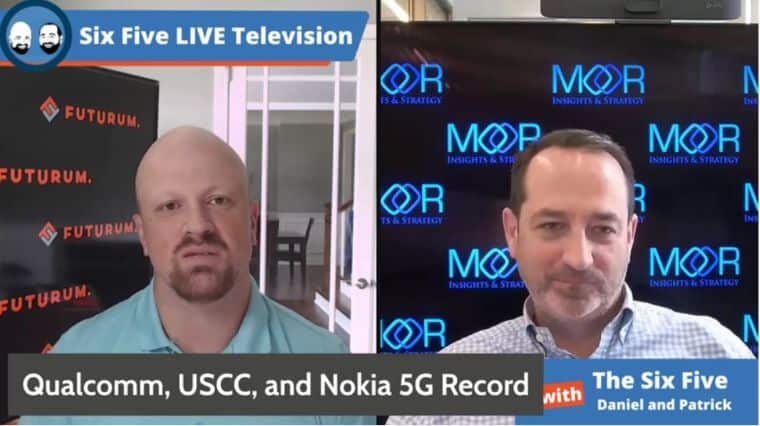The Six Five team discusses the 5G mmWave world record set by Nokia, Qualcomm and UScellular.
Watch the clip below:
If you are interested in watching the full episode you can check it out here.
Disclaimer: The Six Five Webcast is for information and entertainment purposes only. Over the course of this podcast, we may talk about companies that are publicly traded and we may even reference that fact and their equity share price, but please do not take anything that we say as a recommendation about what you should do with your investment dollars. We are not investment advisors and we do not ask that you treat us as such.
Transcript:
Patrick Moorhead: Yeah. Let’s move to Qualcomm, Daniel, and I’m going to give you the lead for this one, but I just, I love speed records.
Daniel Newman: Well, I was trying to do a speed record on talking about Honeywell. I did not succeed with that, but there was just a lot to cover there, Pat. You left me a little oxygen and I sucked it right out. So big news yesterday, actually not yesterday, earlier this week, last week, came out from UScellular, Nokia, Qualcomm, basically succeeding on a milestone around 5G mmWave. Now understand, 5G mmWave is the uber fast, okay? It’s the uber fast 5G, the one that’s going to change our lives and our experiences. And the three companies have come together using Nokia’s extended range, mmWave solution on UScellular production network, and using Snapdragons X55 5G Modem-RF system with their QTM527 mmWave antenna module to set a new world record, getting to near gigabit speeds and on a distance of almost six miles.
Pat, we don’t do a lot of news, that’s the news. Sorry about reading that off, but we got to frame this for people. This is big. Let me tell you why this is big. You go into a big urban city, a big urban city, like New York, Chicago, L.A., San Francisco, soon to be Austin. You go into a big city, you get that 5G, and you get those gig speeds on your device. It’s faster gaming, faster streaming, faster browsing. Whatever you want to do, it’s different, and the experience is next generation.
You go on a 5G Sub-6 network, somewhere out in a rural area, it still feels pretty much like you’re on 4G. It just does. It doesn’t feel that different. What we’ve been waiting for is how do we help rural locations, small cities, towns, places with less infrastructure than we have here, and give those same speeds, that same potential, and put it into our workplaces, our schools, our classrooms, and our homes. This is what the three companies are coming together to accomplish here. They are coming together to basically democratize the highest speed connectivity and make it available to everyone throughout the country. This is a big deal. And of course, once it’s being done here, it can be democratized into other rural areas, other areas with less infrastructure.
And by the way, Pat, before I turn this over to you, all I want to say is, when we talk about an infrastructure bill, we talk about spending trillions of dollars. This is the kind of stuff I expect to hear that we are investing in. I know roads and bridges, but I would really like to hear something about this kind of technology being democratized and made available all over the U.S. and potentially scaling out to around the world.
Patrick Moorhead: Yeah. I mean, this one was pretty straightforward here. I mean, I see like you do a lot of opportunity for rural action here. This one gigabit at 10 kilometers will be fractionalized, but when you compare that to what’s available out there right now, this is far and above what speeds are. And if you’re in rural America, you’re happy to get 10 or 15 megabit per second down, and maybe one or two up. And I live it. I’ve got a place in the country. Actually it’s not even rural. It’s just a lake house. I can barely get coverage out there. So I think this is a real big thing. If you are suburban mmWave, you’ll want to have your antenna outside the home because it’s not as pervasive going inside of homes. So I think this is, from a large Qualcomm point of view, this is one of the big growth business, to fix wireless access that they hadn’t participated in, and the ability to partner with MSOs, partner with carriers to be able to roll this out as another revenue opportunity for Qualcomm.
So Daniel, good analysis on this.
Author Information
Daniel is the CEO of The Futurum Group. Living his life at the intersection of people and technology, Daniel works with the world’s largest technology brands exploring Digital Transformation and how it is influencing the enterprise.
From the leading edge of AI to global technology policy, Daniel makes the connections between business, people and tech that are required for companies to benefit most from their technology investments. Daniel is a top 5 globally ranked industry analyst and his ideas are regularly cited or shared in television appearances by CNBC, Bloomberg, Wall Street Journal and hundreds of other sites around the world.
A 7x Best-Selling Author including his most recent book “Human/Machine.” Daniel is also a Forbes and MarketWatch (Dow Jones) contributor.
An MBA and Former Graduate Adjunct Faculty, Daniel is an Austin Texas transplant after 40 years in Chicago. His speaking takes him around the world each year as he shares his vision of the role technology will play in our future.







